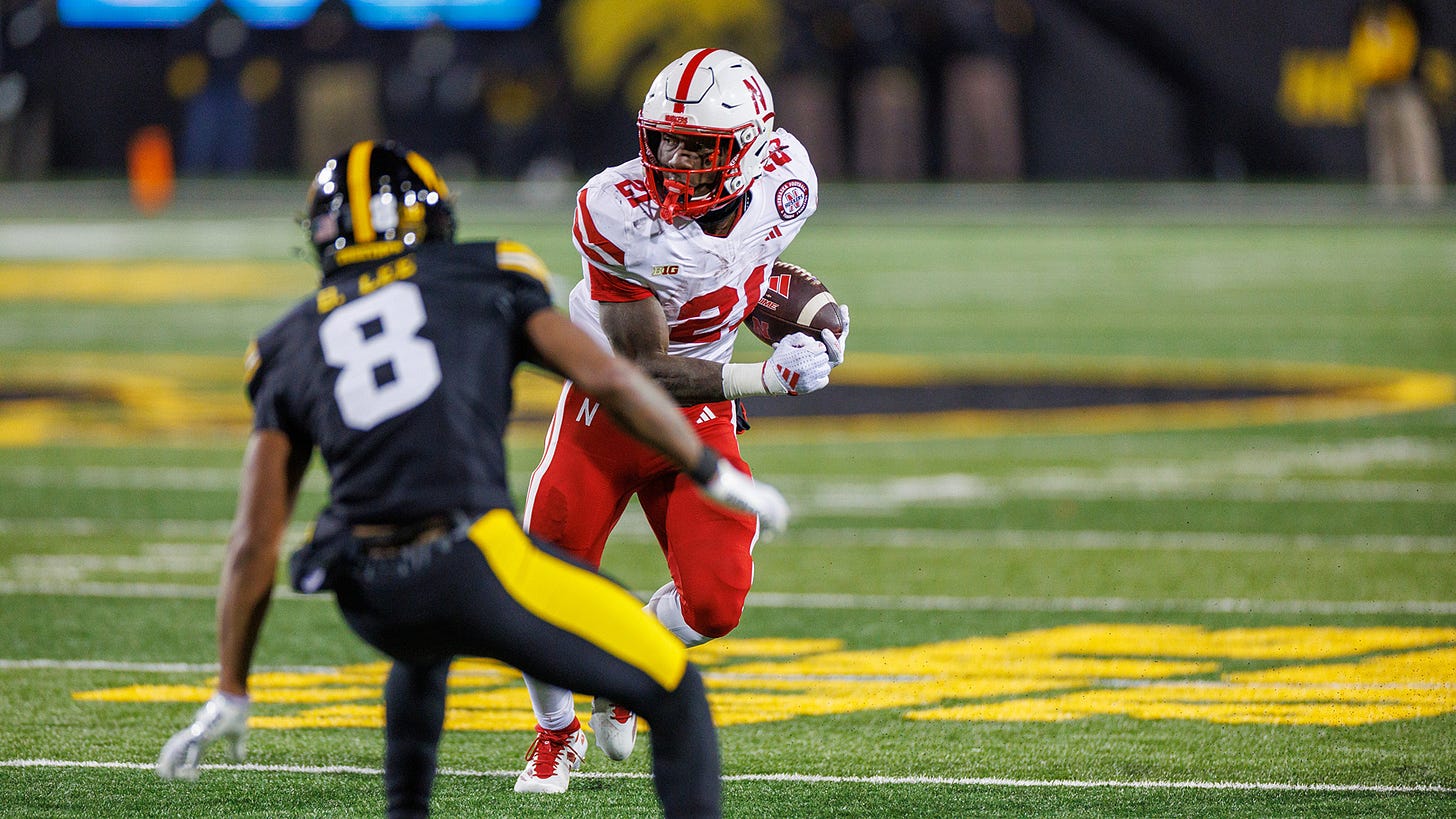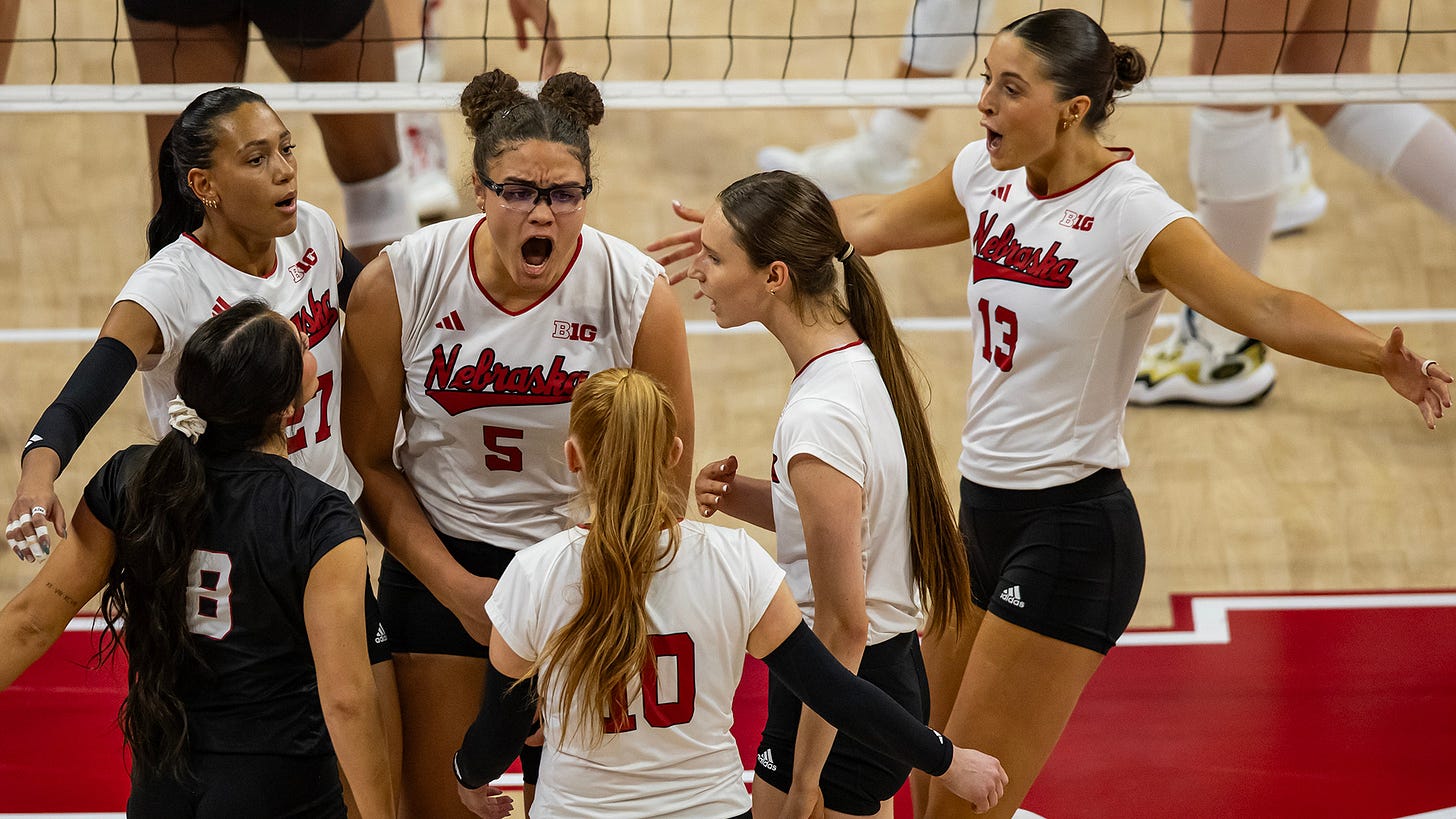And we gravely read the stones
Trying to parse Nebraska football's hard-to-parse 2024.
Nebraska fell to 17-45 in one-score games since 2015 on Friday. If you didn’t know that number off the top of your head, you’ve no doubt felt it over the past decade.
The Black Friday loss to Iowa was different even though it felt exactly the same as last year’s and pretty similar to a couple of others. It was actually the worst one-score loss of the 45 over the past 10 seasons.
Per collegefootballdata.com’s postgame win probability—short definition: “the probability of each team winning should the game be played again with equivalent stats—the Huskers win that game 94% of the time with both teams producing the same underlying numbers. Nebraska has lost close a lot of late, but it’s never lost close while theoretically winning that big.
The next closest one-score loss was…dramatic pause…Nebraska’s loss to Minnesota, also 13-10, to start last season. Those are inconvenient bookends to the Matt Rhule era so far.
I wrestled with my thoughts on the 2024 regular season throughout the weekend. There will be a postseason, so that’s something. But I’m still not sure I have a grip on what the 12 games we just saw meant for Nebraska football.
So I decided to return to what I was writing about the team in the offseason as a guide.
1. Did I see what I needed to see?
Right before the start of the season, I tried to boil a lot of ideas from the offseason down into a concentrated stock of an overarching expectation. Using the Notre Dame-Temple game from 2015 as a lead-in, which the 9th-ranked Irish rallied to win 24-20 in Philadelphia.
From that column:
It wasn’t a fluky game. [Temple AD Pat] Kraft told reporters before kickoff that Temple would be “the most physical team” Notre Dame played that season. Maybe it was, maybe it wasn’t, but the Owls looked like they believed Kraft’s claim. They didn’t just think they would punch the Irish right in the mouth, they played like they had the right to.
Here at the end of the offseason, having processed all the projections and power rankings, having talked through the schedule a thousand times, finding this mindset is the biggest win Nebraska can have in 2024.
Did the Huskers find that mindset? They definitely had it against Colorado. Nebraska was a slight favorite in the game, but that was personal to the players and looked like it.
The better example, however, is the Ohio State game. A humbled Husker team stood toe-to-toe with the Buckeyes on their turf as 23-point underdogs. The Blackshirts held Ohio State’s offense to some numbers it doesn’t see for seasons at a time.1 The offense had to strain for everything it got against a good defense, but it had worse games over the first three-fourths of the season.
“It’s the first time—the first time—the first time since I’ve been here that I felt a championship mindset in the locker room,” Rhule said after the game.
I think the Huskers had the mindset against Iowa, too, despite the so-unbelievable-it’s-routine, so-routine-it’s-unbelievable, ouroboros of angst ending.
So, did I see what I needed to see? I have to answer “yes,” but the 2024 season may not feel like an unqualified success because I wouldn’t say that mindset was a consistent undercurrent for this team. That it showed up, in my estimation, in the three games the Huskers probably cared the most about is maybe the truest reflection of where this program sits after Rhule’s second season.
There are ghosts of the past, both recent and distant, that Rhule didn’t have to deal with at Temple and Baylor. Nebraska played with “we’ll punch anyone in the mouth” energy a few times, but here a team also has to have a “the other guy won’t land a punch” mindset at the ready, too.
2. Was the season a surprise?
Near the start of fall camp, I made the argument that Nebraska had never had a season in the Big Ten that was positively surprising, never a season that was noticeably better than expected.
It’s easy enough to ask an intriguing question and easier still to offer an opinion on one, but I always like to have a baseline for forming an opinion. Here that baseline will be ESPN’s FPI ratings.
Here’s the chart from that original story with Nebraska’s end-of-regular-season rating for 2024 added:
By this model, Nebraska could finish with a better FPI rating than it started the season for just the third time since 2014. It’s a slight difference, up to 6.2 from 4.8, but it’s something.2 I do put some weight in it as metrics like this aim at how a team plays as much as the final results of the games.
That said, as with the other two times Nebraska finished in the FPI black since 2014, the context of the season makes it all but impossible to classify this season as a positive surprise. Nebraska improved by one win—and that bowl game is an important milestone—but it was 1.5 wins below its season win total set by oddsmakers. About two-thirds of FBS teams will finish within 1.5 wins of those totals each year, so it’s not an uncommon miss, but it’s still a miss. The Huskers were favored by at least 6.5 points in seven games this season (a 68.4% win probability or better) and in virtual coinflips against Wisconsin (NU -1) and Iowa (+3). Nebraska lost all four games as an underdog, while dropping two at home as a touchdown favorite.
That’s the margin between 8-4 and 6-6.
Part of the reason, I think, that FPI views the Huskers as a bit better now than at the start of the season is because of the schedule. All offseason it was described as “manageable,” and it did look that way on paper.
Right now, ESPN’s strength-of-schedule model ranks Nebraska’s slate as the 19th-toughest. That’s sixth in the 18-team Big Ten behind Purdue (1-11), Michigan (7-5), Washington (6-6), UCLA (5-7) and Maryland (4-8).
About that.
3. The chaos to come.
I’ll save something longer on this for closer to the Playoff, but of the 17 teams realistically alive for a spot in the 12-team field only three of them had a strength-of-schedule rating from ESPN higher than the Huskers’—Georgia (3rd), South Carolina (15th) and Alabama (16th). The average rank for those 17 teams is 46th.
We’re only one year—the first year, at that—into the 12-team era, but is the best playoff predictor going forward going to be schedule strength? Doesn’t seem like a lot of fun. And it gives a lot of power to the conferences, i.e. the schedule-makers.
I generally buy the argument that the dawn of the super-conference era has produced a more chaotic than normal season. It would’ve been crazy at the start of the year to have Indiana or Arizona State among your playoff contenders, but they’re there and they played the 65th- and 72nd-toughest schedules respectively.3 Iowa State’s also there, winning 10 games for the first time in program history. ESPN ranked the Cyclones’ schedule 68th through Saturday’s games.
Maybe this will prove to be an overreaction, but the first place I’ll look when trying to assess conference and playoff races for 2025 is the schedule, because I’m betting it will be an even more powerful indicator next year.
If 2024 qualified as somewhat chaotic, wait for the first season with a 105-player limit. Rhule said Nebraska could lose 30-40 players to the portal because of it, probably higher than the average team given its roster size but every program is going to lose a chunk of guys. That brings me back to the Huskers’ hard-to-parse season as I consider what things look like in 2025.
Will some of the old offseason predictors—returning starters, returning production, 4-year recruiting rankings—have the same value given the grand reshuffling to come? Probably not.
And maybe that’s good for the Huskers and their ability to surprise in 2025. Hard-to-parse isn’t conducive to offseason buzz. Most will be in wait-and-see mode with NU. Rhule might even show up on some of the national hot-seat lists.
Given all the change that’s coming, maybe not the worst time to not have all the traditional markers of a team on the rise because we don’t know if any of that stuff means what it used to.
Is it too early to take a look at the 2025 schedule? Yeah, I’ll wait until January. Probably.4
To the Court
Following Friday’s loss to Penn State, Nebraska volleyball beat Maryland to earn a share of the regular-season Big Ten title. You’re not going to believe this, but the Huskers (29-2) earned a 1-seed in the NCAA Tournament and were the second seed overall behind Pittsburgh. Nebraska opens tournament play at home Friday at 7 p.m. against Florida A&M. Eight-seed Miami and South Dakota State will also be in Lincoln.
Plenty more to come on the tournament as the week progresses.
Though Michigan showed OSU some again on Saturday.
The Elo model I mentioned a couple of weeks ago would still differ, finding NU a bit worse than at the start of the season.
Personally, I don’t really ding teams for this. Win your games. I want Indiana and Arizona State in this thing.
We started the impromptu musical collaboration here, so only fitting it ended here.





